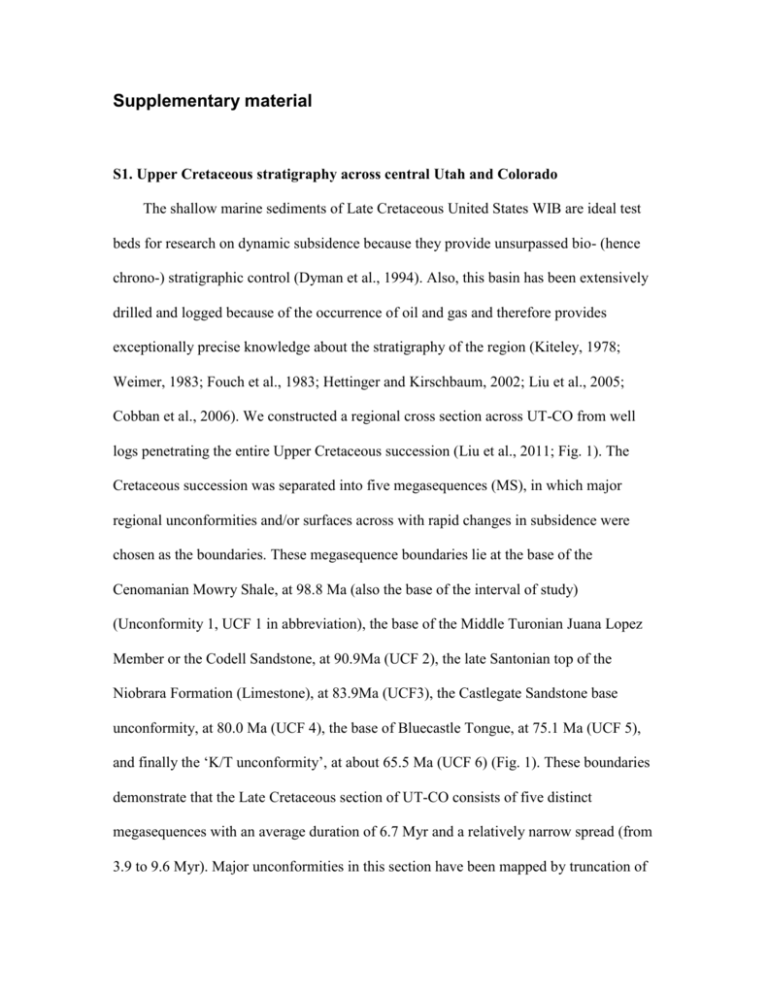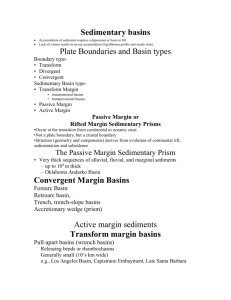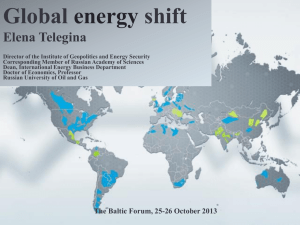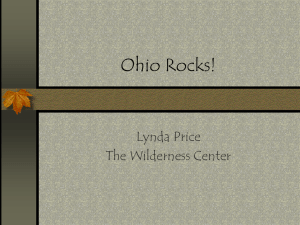Dynamic versus flexural controls of Late Cretaceous Western Interior
advertisement

Supplementary material S1. Upper Cretaceous stratigraphy across central Utah and Colorado The shallow marine sediments of Late Cretaceous United States WIB are ideal test beds for research on dynamic subsidence because they provide unsurpassed bio- (hence chrono-) stratigraphic control (Dyman et al., 1994). Also, this basin has been extensively drilled and logged because of the occurrence of oil and gas and therefore provides exceptionally precise knowledge about the stratigraphy of the region (Kiteley, 1978; Weimer, 1983; Fouch et al., 1983; Hettinger and Kirschbaum, 2002; Liu et al., 2005; Cobban et al., 2006). We constructed a regional cross section across UT-CO from well logs penetrating the entire Upper Cretaceous succession (Liu et al., 2011; Fig. 1). The Cretaceous succession was separated into five megasequences (MS), in which major regional unconformities and/or surfaces across with rapid changes in subsidence were chosen as the boundaries. These megasequence boundaries lie at the base of the Cenomanian Mowry Shale, at 98.8 Ma (also the base of the interval of study) (Unconformity 1, UCF 1 in abbreviation), the base of the Middle Turonian Juana Lopez Member or the Codell Sandstone, at 90.9Ma (UCF 2), the late Santonian top of the Niobrara Formation (Limestone), at 83.9Ma (UCF3), the Castlegate Sandstone base unconformity, at 80.0 Ma (UCF 4), the base of Bluecastle Tongue, at 75.1 Ma (UCF 5), and finally the ‘K/T unconformity’, at about 65.5 Ma (UCF 6) (Fig. 1). These boundaries demonstrate that the Late Cretaceous section of UT-CO consists of five distinct megasequences with an average duration of 6.7 Myr and a relatively narrow spread (from 3.9 to 9.6 Myr). Major unconformities in this section have been mapped by truncation of key markers in the subsurface (Kiteley, 1978; Weimer, 1983; Fouch et al., 1983; Hettinger and Kirschbaum, 2002), providing a regionally consistent framework. Megasequence 1 (MS 1) extends from the early Cenomanian (98.8 Ma) to the Turonian (90.9 Ma). The base of this megasequence conforms to the regional unconformity separating the Mowry Shale/Frontier Formation/Dakota Sandstone from the Lower Cretaceous (that includes the Skull Creek and Fall River Formations). The top is a regional unconformity within the Ferron Sandstone, at the base of Juana Lopez Member and the Codell Sandstone (Fig. 1). In the correlation section, the thickness of MS 1 decreases abruptly from west to east. On the western margin of the Wasatch Plateau (Well 1) it is 598 meters thick. It pinches out about 96 m farther to the east at the western margin of the Piceance basin (Well 7), and then increases to the east of Well 8. Lithofacies in MS 1 change laterally from interbedded marine and nonmarine sandstone wedges and shale in Well-1 and 2 to fully marine shale and sandstones in the central part of the section, then to marine shale and marine calcareous shale and limestone in the eastern part of the section. Megasequence 2 (MS 2), which extends from the Turonian (90.9Ma) to the very late Santonian (83.9Ma), incorporates the upper Ferron Sandstone, Juana Lopez Member, Lower Blue Gate Shale, Codell Sandstone, Niobrara marine calcareous shale and limestone, and the lower Emery Sandstone Member (Fig. 1). The top of this megasequence is stratigraphically fairly indistinct, with a regional downlap onto the Niobrara Formation east of Front Range (Fig. 1). The thicknesses of MS 2 in the correlation section increases from the east to west, and are 1078 m in the Well-1 in front of the Sevier thrust belt and 116 m at the eastern end, which is in a typical wedge shape with ~ 800 km width. Lithofacies change laterally from a progradational sequence vertically stacked with marine shale and sandstone, and shore face and nonmarine sandstone in Well 1, 2 and 3, to fully marine shale in Well 4, 5 and 6, then to marine shale and marine calcareous shale and limestone (Niobrara Formation) to the east of Well 6. The progradational wedge of Lower Emery Sandstone Member and its counterparts pinches out at the middle of the section, and downlaps onto the top of the Niobrara limestone beds between Well-7 and Well-12 (Fig. 1). Megasequence 3 (MS 3), which extends from the latest Santonian (83.9 Ma) to the middle Campanian (80.0 Ma), spans a series of major fore-stepping sequence sets in the Wasatch Plateau and Uinta Basin, including the Star Point Sandstone and the Blackhawk Formation of Aberdeen Member, Kenilworth Member, Sunnyside Member, Grassy Member and Desert Member. The Star Point Sandstone and Blackhawk Formation constitute eastward progradational wedges of coastal plain and shoreface sandstone and shale, interfingering with the Mancos marine shale. To the east of Well 4, the section is mostly composed of marine shale, and the lower part of Mancos Shale downlaps onto the top of the Niobrara limestone beds to the east of Well-12, and greatly pinches out eastwards (Fig. 1). The overall architecture across UT-CO in MS 3 and the upper part of MS 2 constitutes a large scale clinoform-like set, representing a general eastward progradation pattern with regional downlap onto the Niobrara Formation. The stratigraphic correlation demonstrates that the absence of the Desert Member to west of Well-4 reflects uplift and erosion along UCF4 over the Wasatch Plateau (Fig. 1). The thickness of MS 3 is lightly increased westward to the west of Well-12, but greatly pinches out to the east of Well-12. The greatest thickness is 779 m at Well-8 in the central part of the section, and the smallest thickness is about 10 m to the east of Well-19. In comparison with MS 2, the depocenter of MS 3 migrates eastwards. Megasequence 4 (MS 4), which extends from 80.0 Ma to 75.1 Ma in the middle Campanian and is lens-shaped in east-west cross-section, includes the Castlegate Sandstone, Buck Tongue of Mancos shale, Sego Sandstone, Anchor Mine Tongue, and Neslen Formation in the western part of the section, and their equivalent part of the Mancos Shale in the central and eastern parts of the section (Fig. 1). MS 4 mostly consists of nonmarine sandstone, estuarine sandstone and mudstone to the west of Well-3, progradational shoreface deposits between Well-4 and Well-8, and the marine shale of the Mancos Formation to the east of Well 8. The thickness of MS 4 is increased eastward, and then pinches out to the east of Well-14. The greatest thickness is 654 m at Well-13 at the western side of Denver Basin, and the smallest thickness is about 64 m at Well-1. The depocenter of MS 4 continuously migrated to the western Denver Basin. At the westernmost part of the section, localized unconformities are frequently developed, which suggest that intermittent uplift and erosion were experienced toward the end of Cretaceous (Fig. 1). Megasequence 5 (MS 5), which extends from 75.1 Ma to 65.5 Ma in the Late Campanian and Maastrichtian, includes the Bluecastle Tongue, the Price River, Farrer and Tuscher Formations, Williams Fork Fm. and Rollins Ss. Mbr., and their equivalent parts in the eastern part of the section (Fig. 1). The stratigraphy in the middle of the section from Well-11 to Well- 12 at the Front Range missed due to erosion. The top of MS 5 is the ‘K/T unconformity’ at the base of the Paleocene Fort Union, North Horn, and Wasatch Formations (Fig. 1). This surface can be traced across much of Utah and Colorado, and is probably a polygenetic surface related to partial overlap in timing of uplifts of several Laramide ranges (Liu et al., 2005). MS 5 is also lens-shaped with a maximum thickness at Well-13, partly reflecting greater deposition toward the western margin of Denver Basin as well as greater subsequent erosion to the west of the basin (Fig. 1). As for Front Range uplift and erosion, MS 5 deposited in Denver Basin is hard to correct with that in Piceance Basin, but the marine deposits may interfinger westward with Rollins Sandstone Member and Williams Fork shoreface sandstones, coastal plain, and fluvial deposits. This indicates that the Western Interior Seaway gradually withdrew as sediment prograded eastwards, and the western margin of the basin uplifted and eroded (Fig. 1), and the depocenter continuously migrated eastwards. References: Cobban, W.A., Obradovich, J.D., Walaszcyk, I., McKinney, K.C., 2006. A USGS Zonal Table for the Upper Cretaceous Middle Cenomanian-Maastrichtian of the Western Interior of the United States Based on Ammonites, Inoceramids, and Radiometric Ages. U.S. Geological Survey Open-File Report 2006-1250, 46 p. Dyman, T.S., Merewether, E.A., Molenaar, C.M., Cobban, W.A., Obradovich, J.D., Weimer, R.J., Bryant, W.A., 1994. Stratigraphic transects for Cretaceous rocks, Rocky Mountains and Great Plains regions, in: Caputo, M.V., Peterson, J.A., Franczyk, K.J. (Eds.), Mesozoic systems of the Rocky Mountain region, USA, Denver, Colorado, Rocky Mountain Section SEPM, pp. 365–392. Fouch, T.D., Lawton, T.F., Nichols, D.J., Cashion, W.B., Cobban, W.A., 1983. Patterns and timing of synorogenic sedimentation in Upper Cretaceous rocks of central and northeast Utah, in: Reynolds, M.W., and Dolly, E.D. (Eds.), Mesozoic paleogeography of the west-central United States, Denver, Colorado, Rocky Mountain Section, SEPM, pp. 305–336. Hettinger, R.D., Kirschbaum, M.A., 2002. Stratigraphy of the Upper Cretaceous Mancos Shale (Upper Part) and Mesaverde Group in the Southern Part of the Uinta and Piceance Basins, Utah and Colorado. U.S. Geological Survey Geologic Investigations Series I-2764, pp. 1-22. Kiteley, L.W., 1978. Stratigraphic sections of Cretaceous rocks of the northern Denver Basin, northeastern Colorado and southeastern Wyoming. Department of the Interior, United States Geological Survey. Liu, S.F., Nummedal, D., Liu, L.J., 2011. Migration of dynamic subsidence across the Late Cretaceous United States Western Interior Basin in response to Farallon plate subduction. Geology 39, 555-558. Liu, S.F., Nummedal, D., Yin, P.G., Luo, H.J., 2005. Linkage of Sevier thrust episodes and Late Cretaceous megasequences across southern Wyoming (USA). Basin Res. 17, 487-506. Weimer, R.J., 1983. Relation of unconformities, tectonics and sea level changes, Cretaceous of the Denver basin and adjacent areas, in: Reynolds, M.W., Dolly, E.D. (Eds.), Mesozoic Paleogeography of West-Central United States, Rocky Mountain Section SEPM, pp. 359-376. S2. Methods The 1-D subsidence analysis includes decompaction, correction for water depth. The eustatic variations are negligible in amplitude for the time interval considered here (Müller et al., 2008). The methodology of the 1-D subsidence analysis was conducted by procedures described in Liu et al. (2005) (Angevine et al., 1990; Sclater and Christie, 1980), and the empirical constants in the exponential porosity-depth relations for four kinds of lithological units (including sandstone, shaly sandstone, shale and limestone) and paleo-bathymetry ranges for different units of the Upper Cretaceous were cited from Tables 1 and 2 of Liu et al. (2005) (Weimer, 1983; Sageman and Arthur, 1994). In the 2D subsidence analysis, we backstripped 24 stratigraphic columns of well log sections across the UT-CO, which is shown in Figure 1, and calculated the cumulative total subsidence at the each well log section across the basin at different age levels of 75.1, 80.0, 83.9 and 90.9 Ma. The cumulative subsidence for each well log section at the four basal levels was compiled together according to their location in Figures 1 to obtain 2-D cumulative total subsidence across the UT-CO profile (Fig. 2). Flexural backstripping for the elastic lithosphere along the cross section was calculated by choosing five reference levels, 90.9, 83.9, 80.0, and 75.1 Ma. A range of flexural rigidities, 1021, 1022, 1022.5, 1023, and 1024 Nm, were analyzed in this modeling. It was found that 1023 Nm provided consistently the best fit, in which simulated cumulativesubsidence driven by thrust and sediment plus water load and decompacted total subsidence were parallel, and the simulated cumulative-subsidence profiles had no any abrupt change and kept stable development, at all different stages (Fig. 3). Therefore, 1023 Nm was chosen to be flexural rigidity for the UT-CO section, which has a very little difference from those of 1023 (Jordan, 1981), 5×1022 (Luo et al., 2010), and 1022.5 (Liu and Nummedal, 2004) used in the Rocky Mountain area before. The flexural rigidity is related the effective elastic thickness of crust. The little difference of mechanics of the crust might be the explanation why we had different rigidities from others. Thrust load estimates are derived from cross section A-A’ of DeCelles and Coogan (2006; their Figure 3) which traverses the Sevier thrust belt immediately west of the end of stratigraphic UT-CO section (Section I-I’, Fig. 1). Four main thrusts, the Canyon Range thrust, Pavant thrust, Paxton thrust and Gunnison thrust, are stacked in an eastward overlapping array. DeCelles and Coogan (2006; their Figure 8) restored a series of sequentially balanced, structural sections across the central Utah segment of the Sevier thrust belt at ca. 75-66, 88-75, 93-88, 110-93, >110 Ma. Restoration indicates that crustal thickening due to thrusting amounted to ~16 km in western Utah, and formed > 3 km of regional elevation in the Sevier hinterland. This episodic thrusting and thickening controlled the major subsidence in the foredeep of central-eastern Utah during the Late Cretaceous. The flexural subsidence includes the components of sediment plus water load within the basin, which is the preserved sediments shown above the heavy black lines and the restored sediment wedge near the thrust belt shown by dashed lines, that has been removed by subsequent thrusting and erosion, the thickness of which was assumed to fit the adjacent preserved sediment thickness and also conform to the shape of the total subsidence curve (Fig. 3). The water depth was determined according to the depositional environment of the stratigraphy at the reference levels. At any given time of thrusting, this sediment load was on the basinward side of the leading thrust. The simulated cumulative subsidence curves (heavy green lines in Fig. 3) caused by the whole thrust load and the original sediment plus water load in general parallel the observed total subsidence curves (heavy black lines). The simulation shows a narrow foredeep (~180 km wide) and a very gentle forebulge in front of the thrust belt. The forebulge slightly migrated eastwards from Well 3 to Well 4 in response to this complete load (lower arrows in Fig. 3). The dynamic subsidence—the difference between the cumulative flexural subsidence and the observed total subsidence (yellow band, Fig. 3)—develops a westward-thickening wedge, and its average thickness gradually increases from 178 m in the first stage, to 388 m in the second stage, to 560 m in the third stage, and to 708 m at the last stage (Fig. 3a to 3d). In order to show the evolution of dynamic subsidence in different incremental stages (98.8-90.9 Ma, 90.9-83.9 Ma, 83.9-80.0 Ma, and 80.0-75.05 Ma), we differentiated the cumulative total dynamic subsidence into incremental subsidence at each stage (Fig. 4). References: Angevine, C.L., Heller, P.L., Paola, C., 1990. Quantitative Sedimentary Basin Modeling. American Association of Petroleum Geologists Shortcourse Note Series 32. DeCelles, P.G., Coogan, J.C., 2006. Regional structure and kinematic history of the Sevier fold-and-thrust belt, central Utah. Geol. Soc. Am. Bull. 118, 841-864. Jordan, T.E., 1981. Thrust loads and foreland basin evolution, Cretaceous, western United States. Am. Assoc. Pet. Geol. Bull. 65, 2506-2520. Liu, S.F., Nummedal, D., 2004. Late Cretaceous subsidence in Wyoming: Quantifying the dynamic component. Geology 32, 397–400. Liu, S.F., Nummedal, D., Yin, P.G., Luo, H.J., 2005. Linkage of Sevier thrust episodes and Late Cretaceous megasequences across southern Wyoming (USA). Basin Res. 17, 487-506. Luo, H.J., Nummedal, D., Liu, S.F., 2010. 3-D flexural numerical modeling of foreland basins: an example from the Upper Cretaceous across the southwestern Wyoming. Earth Sci. Frontiers 17, 128-139. Müller, R.D., Sdrolias, M., Gaina, C., Steinberger, B., Heine, C., 2008. Long-term sealevel fluctuations driven by ocean basin dynamics. Science 319, 1357-1362. Sageman, B.B., Arthur, M.A., 1994. Early Turonian paleogeographic/paleobathymetric map, western Interior, U.S., in: Caputo, M., Peterson, J. (Eds.), Mesozoic systems of the Rocky Mountain region, U. S., Rocky Mountain section, SEPM special publication, pp. 457-470. Sclater, J.G., Christie, P.A.F., 1980. Continental stretching: An explanation of the postmid-Cretaceous subsidence of the central North sea basin. J. Geophys. Res. 85, 37113739. Weimer, R.J., 1983. Relation of unconformities, tectonics and sea level changes, Cretaceous of the Denver basin and adjacent areas, in: Reynolds, M.W., Dolly, E.D. (Eds.), Mesozoic Paleogeography of West-Central United States, Rocky Mountain Section SEPM, pp. 359-376.
![Georgina Basin Factsheet [DOCX 1.4mb]](http://s3.studylib.net/store/data/006607361_1-8840af865700fceb4b28253415797ba7-300x300.png)







